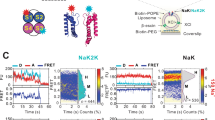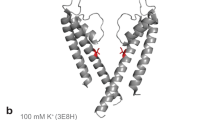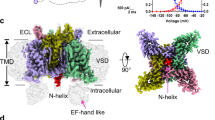Abstract
The voltage-sensitive gates regulating the permeability of ionic channels in nerve membrane were originally thought to be insensitive to the concentration1 and species2,3 of readily permeant cations. In contrast, blocking cations—tetraethyl-ammonium4, N-methylstrychnine5 or pancuronium6—when present in the inner end of potassium or sodium channels, hinder closing of the gates by a ‘foot in the door’ effect. Recent work on acetylcholine channels has clearly shown that the lifetime of the conducting state is prolonged by certain species of permeant cations7,8. In this case, the presence of a permeant ion near the inner end of the channel is thought to prevent closing. Somewhat similar effects have recently been reported for the K+ channels of nerve membrane9–11. We report here unequivocal evidence that the permeant cations K+ and Rb+ when present externally, slow the closing of K+ channels in squid axon, supporting the view that gating is indeed sensitive to the presence and species of permeant cations in the channels.
This is a preview of subscription content, access via your institution
Access options
Subscribe to this journal
Receive 51 print issues and online access
$199.00 per year
only $3.90 per issue
Buy this article
- Purchase on Springer Link
- Instant access to full article PDF
Prices may be subject to local taxes which are calculated during checkout
Similar content being viewed by others
References
Hodgkin, A. L. & Huxley, A. F. J. Physiol., Lond. 116, 449–472 (1952).
Chandler, W. K. & Meves, H. J. Physiol., Lond. 180, 788–820 (1965).
Hille, B. J. gen. Physiol. 58, 599–619 (1971).
Armstrong, C. M. J. gen. Physiol. 58, 413–437 (1971).
Cahalan, M. D. & Almers, W. Biophys. J. 27, 57–74 (1979).
Yeh, J. Z. & Armstrong, C. M. Nature 273, 387–389 (1978).
Ascher, P., Marty, A. & Neild, T. O. J. Physiol., Lond. 278, 177–206 (1978).
Marchais, D. & Marty, A. J. Physiol., Lond. 297, 9–45 (1979).
Århem, P. Acta physiol. scand. 108, 7–16 (1980).
Dubois, J. M. & Bergman, C. Pflugers Arch. ges Physiol. 370, 185–194 (1977).
Stühmer, W. & Conti, F. in A. Meet. Deutsche Gesellschaft Biophysik (eds Adam, G. & Stark, G.) (Springer, New York, 1979).
Bezanilla, F. & Armstrong, C. M. J. gen. Physiol. 70, 549–566 (1977).
Frankenhauser, B. & Hodgkin, A. L. J. Physiol., Lond. 131, 341–376 (1956).
Hille, B. in Membranes. A Series of Advances Vol. 3 (ed. Eisenman, G.) (Dekker, New York, 1975).
Armstrong, C. M. & Taylor, S. R. Biophys. J. 30, 473–488 (1980).
Author information
Authors and Affiliations
Rights and permissions
About this article
Cite this article
Swenson, R., Armstrong, C. K+ channels close more slowly in the presence of external K+ and Rb+. Nature 291, 427–429 (1981). https://doi.org/10.1038/291427a0
Received:
Accepted:
Issue Date:
DOI: https://doi.org/10.1038/291427a0
This article is cited by
-
Structural basis for the coupling between activation and inactivation gates in K+ channels
Nature (2010)
-
Molecular driving forces determining potassium channel slow inactivation
Nature Structural & Molecular Biology (2007)
-
Molecular determinants of gating at the potassium-channel selectivity filter
Nature Structural & Molecular Biology (2006)
-
Allosteric effects of external K+ ions mediated by the aspartate of the GYGD signature sequence in the Kv2.1 K+ channel
Pflügers Archiv - European Journal of Physiology (2006)
-
Chemistry of ion coordination and hydration revealed by a K+ channel–Fab complex at 2.0 Å resolution
Nature (2001)
Comments
By submitting a comment you agree to abide by our Terms and Community Guidelines. If you find something abusive or that does not comply with our terms or guidelines please flag it as inappropriate.



